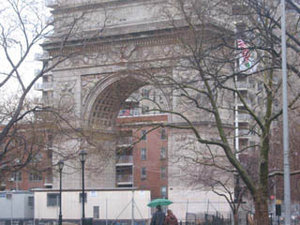Greenwich Village
|
|
The district was better known as Washington Square in the 19th century.
| Contents |
Layout
As Greenwich Village was once a rural hamlet, entirely separate from New York, its street layout does not coincide with most of Manhattan's more formal grid plan (based on the Commissioners' Plan of 1811). Greenwich Village was allowed to keep its street pattern when the plan was implemented, which has resulted in a neighborhood whose streets are dramatically different, in layout, from the ordered structure of other parts of town. Many of the neighborhood's streets are narrow and some curve at odd angles. Additionally, unlike most of Manhattan, streets in the Village typically are named rather than numbered.
History
Greenwich Village, a small settlement separate from the larger (and fast-growing) Manhattan, officially became a village in 1712. In 1822, a yellow fever epidemic in New York encouraged residents to flee to the more healthful air of Greenwich Village, and afterwards many stayed.
Greenwich Village is generally known as an important landmark on the map of bohemian culture. The neighborhood is known for its colorful, artistic residents and the alternative culture they propagate. Due in part to the progressive attitudes of many of its residents, the Village has traditionally been a focus point of new movements and ideas, whether political, artistic, or cultural.
During the golden age of bohemia Greenwich Village became famous for eccentrics such as Joe Gould (profiled at length by Joseph Mitchell) and Maxwell Bodenheim, as well as greats on the order of Eugene O'Neill. Political rebellion also made its home here, whether serious (John Reed) or frivolous (Marcel Duchamp and friends set off balloons from atop Washington Square arch and declared the Village independent).
The Village again became important to the bohemian scene during the 1950's, when the Beat Generation focused their energies there. Fleeing from what they saw as oppressive social conformity, a loose collection of writers, poets, artists, and students (later known as the Beats) moved to Greenwich Village, in many ways creating the East-Coast predecessor to the Haight-Ashbury hippie scene of the next decade. The Village (and surrounding New York City) would later play central roles in the writings of Jack Kerouac, Allen Ginsberg, and William S. Burroughs, among others.
Greenwich Village played a major role in the development of the folk music scene of the 1960's. Three of the four members of the The_Mamas_&_the_Papas met there. Village resident Bob Dylan was one of the foremost popular songwriters in the country, and often developments in New York City would influence the simultaneously occuring folk-rock movement in San Francisco, and vice versa.
In recent days, the Village has mantained its role as a center for "progressive," alternative thought: for example, its role in the gay liberation movement. It contains Christopher Street and the Stonewall Inn, important landmarks, as well as the world's oldest gay and lesbian bookstore, Oscar Wilde Bookshop, founded in 1967.
Present Day
Greenwich_Village.jpg
Greenwich Village includes the primary campus for New York University (NYU), New School University, and Yeshiva University's Benjamin N. Cardozo School of Law. Cooper Union is located in neighboring East Village.
The historic Washington Square Park is the center and heart of the neighborhood, but the Village has several other, smaller parks: Father Fagan, Minetta Triangle, Petrosino Square, Little Red Square, and Time Landscape. There are also city playgrounds: Desalvio, Minetta, Thompson Street, Mercer Street, and William Passannante Ballfield. Perhaps the most famous, though, is "The Cage", officially known as the West 4th Street Courts. Sitting on top of the West 4th subway station at 6th Avenue that serves the A-B-C-D-E-F-V trains, the courts are easily accessible to basketball and American handball players from all over New York. The Cage has become one of the most important tournament sites for the city-wide "Streetball" amateur basketball tournament.
The Village also has a bustling performing arts scene. It is home to many Off-Broadway theaters; for instance, Blue Man Group has taken up residence in the Astor Place Theater. The Village Vanguard hosts some of the biggest names in the contemporary jazz on a regular basis. Comedy clubs dot the Village as well, including The Boston and Comedy Cellar, where many American stand-up comedians got their start.
Several publications have offices in the Village, most notably the newsweekly The Village Voice.
The Village is also the setting for Jonathon Larson's sensationally popular Broadway musical, Rent.
See also
External link
- Greenwich Village Society for Historic Preservation (http://www.gvshp.org/history.htm)de:Greenwich Village
fr:Greenwich Village pl:Greenwich Village pt:Greenwich Village

